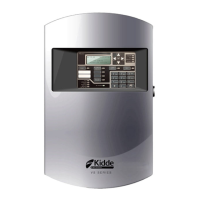Chapter 2: Front panel programming
68 P/N 3102351-EN • REV 005 • ISS 28DEC18
Auto programming the panel
Auto programming detects and applies default settings to installed devices, NACs, remote
annunciators, and expansion cards. You can control many aspects of the process by
programming the options listed in:
• “Auto programming options” below
• “Dialer options” on page 70
• “NET options” on page 72
Auto programming sets up a common alarm system. After the auto programming process has
finished, you can continue with advanced programming to apply any custom settings that may
be required.
Caution: Auto programming replaces the current settings for devices, NACs, remote
annunciators, and expansion cards with default settings.
Notes
• Before starting the auto programming sequence, set the time and date and change the
default passwords. See “Factory default settings” on page 42. for a list of all the settings
that will be applied during auto programming.
• Auto programming places most input devices (alarm device type) and NACs in correlation
group 001. Relay and sounder bases are not automatically assigned to correlation groups.
For more information on correlation groups, see “What is a correlation group?” on page 37
and “Correlation group programming” on page 83.
• Auto programming turns off the In Suite Signal Silence option for all correlation groups.
• If you choose to label devices during auto programming, devices are labeled by entering
the address of the device and then labeling the device. It is important for you to have a
printout of the Device Details > Serial Number report to correlate the device address with
the default label and serial number. This will make device labeling much easier.
• Auto programming will not allow for REL configuration. You must configure a REL from the
VS-CU.
Auto programming options
Table 20 on page 69 describes the options to be set when auto programming the panel.

